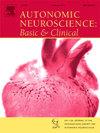The effects of isometric handgrip and post-exercise circulatory occlusion on muscle sympathetic nerve activity: A systematic review and meta-analysis
IF 3.3
4区 医学
Q2 NEUROSCIENCES
引用次数: 0
Abstract
This systematic review and meta-analysis was conducted to identify a ‘normative’ sympathetic response to isometric handgrip and post-exercise circulatory occlusion. Structured searches of databases were performed until June 2024. We included all primary studies (other than systematic reviews and meta-analyses), and inclusion criteria were: population (all populations); intervention (isometric handgrip and post-exercise circulatory occlusion); comparator (baseline); and outcome (MSNA). One-hundred fifty-eight studies (n = 3551) were included. Burst frequency was elevated during handgrip (n = 1853; MD, 12.19bursts/min; 95 % CI, 11.09, 13.28; I2 = 94 %; p < 0.00001) and during PECO (n = 948; MD, 11.42bursts/min; 95 % CI, 10.10, 12.75; I2 = 65 %; p < 0.00001). A similar pattern was observed for burst incidence in handgrip (n = 1074; MD, 8.50bursts/100 hbs; 95 % CI, 7.07, 9.93; I2 = 39 %; p < 0.00001) and PECO (n = 560; MD, 14.87bursts/100 hbs; 95 % CI, 12.65, 17.10; I2 = 43 %; p < 0.00001). Subgroup analyses indicated a larger response in burst frequency and incidence during handgrip exercise in healthy individuals compared to individuals with cardiovascular diseases or other conditions (p < 0.05). A similar response in burst frequency to PECO was observed with subgroup differences between healthy individuals and individuals with cardiovascular diseases and other conditions (p < 0.00001). MSNA is elevated during handgrip exercise across a range of handgrip protocols, populations, and co-interventions. Increases in MSNA during PECO supports the role of the metaboreflex separate to the exercise pressor reflex. A blunted sympathetic response to handgrip and PECO in individuals with cardiovascular diseases contradicts the current understanding of general sympathetic hyperactivity in these populations.
等长握力和运动后循环闭塞对肌肉交感神经活动的影响:一项系统回顾和荟萃分析
本系统综述和荟萃分析旨在确定对等距握力和运动后循环闭塞的“规范”交感神经反应。数据库的结构化搜索一直进行到2024年6月。我们纳入了所有的初步研究(除了系统评价和荟萃分析),纳入标准为:人群(所有人群);干预(等距握拳和运动后循环闭塞);比较器(基线);结果(MSNA)。纳入158项研究(n = 3551)。握力时突发频率升高(n = 1853;医学博士,12.19 /分钟爆发;95% ci, 11.09, 13.28;i2 = 94%;p & lt;0.00001)和PECO期间(n = 948;医学博士,11.42 /分钟爆发;95% ci, 10.10, 12.75;i2 = 65%;p & lt;0.00001)。在握力中也观察到类似的爆裂发生率(n = 1074;MD: 8.50脉冲/100小时;95% ci, 7.07, 9.93;i2 = 39%;p & lt;0.00001)和PECO (n = 560;MD, 14.87脉冲/100小时;95% ci, 12.65, 17.10;i2 = 43%;p & lt;0.00001)。亚组分析表明,与患有心血管疾病或其他疾病的个体相比,健康个体在握力锻炼期间突发频率和发生率方面的反应更大(p <;0.05)。在健康个体和心血管疾病及其他疾病个体之间观察到对PECO突发频率的类似反应,但存在亚组差异(p <;0.00001)。在一系列的握法、人群和联合干预措施中,握法运动期间的MSNA升高。在PECO期间,MSNA的增加支持代谢反射与运动加压反射分离的作用。心血管疾病患者对握力和PECO的交感神经反应迟钝,这与目前对这些人群交感神经过度活跃的理解相矛盾。
本文章由计算机程序翻译,如有差异,请以英文原文为准。
求助全文
约1分钟内获得全文
求助全文
来源期刊
CiteScore
5.80
自引率
7.40%
发文量
83
审稿时长
66 days
期刊介绍:
This is an international journal with broad coverage of all aspects of the autonomic nervous system in man and animals. The main areas of interest include the innervation of blood vessels and viscera, autonomic ganglia, efferent and afferent autonomic pathways, and autonomic nuclei and pathways in the central nervous system.
The Editors will consider papers that deal with any aspect of the autonomic nervous system, including structure, physiology, pharmacology, biochemistry, development, evolution, ageing, behavioural aspects, integrative role and influence on emotional and physical states of the body. Interdisciplinary studies will be encouraged. Studies dealing with human pathology will be also welcome.

 求助内容:
求助内容: 应助结果提醒方式:
应助结果提醒方式:


